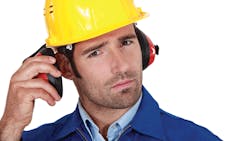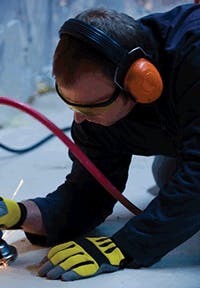A well-fitted earplug or earmuff is enough to protect workers against noise exposure in most industrial environments today. However, when noise exposure exceeds the capabilities of traditional hearing protection, employers need to take special measures.
In environments where intensely loud noise can't be controlled at the source, it might be necessary for workers to wear earplugs and earmuffs at the same time – often referred to as "dual hearing protection" or "double hearing protection."
Typically, dual hearing protection only is appropriate for extreme situations, when noise exposures in the workplace exceed 105 dBA time-weighted average (TWA). In fact, under 30 CFR Part 62, MSHA requires dual protection in such circumstances. NIOSH supports a more conservative approach, recommending a combination of earplugs and earmuffs for exposures over 100 dBA TWA.
Dual hearing protection also can be a viable option for users who want extra protection or wish to reduce the annoyance of background noise. But a note of caution: When workers have more protection than needed, it can hinder their ability to communicate and detect warning signals.
The Basics of Dual Protection
The first step in choosing dual hearing protection is to select a well-fitted, quality earplug. The earmuff adds extra protection, but the style and type of earmuff have less impact on the resulting combined noise reduction. Adding an earmuff over an earplug usually provides a bigger boost in attenuation for low-frequency (pitch) sounds. Overall added protection is about 4 to 8 dB, a significant increase. The OSHA Technical Manual specifies adding 5 dB when evaluating dual hearing-protector performance.
Despite the extra protection provided by dual hearing protection, employers also need to consider potential obstacles. Most notably, wearing two hearing protectors simultaneously can be uncomfortable. As mentioned earlier, too much protection can interfere with communication and situational awareness, making the worker feel isolated or unsafe.
No matter how high the protection rating, there's little benefit if employees fail to wear the hearing protectors consistently and correctly.
Calculating Dual NR Ratings
Two of the most popular options for assessing the noise reduction provided by dual hearing protection are the noise-reduction rating (NRR) method and the personal attenuation rating (PAR) method.
Use the NRR method if you're basing your calculations on laboratory-derived noise-reduction ratings provided by the hearing-protector manufacturer. If you've conducted individual fit testing for the worker – resulting in an overall single attenuation rating – use the PAR method.
Individual fit testing can provide a more accurate indication of real-world hearing-protector performance and is a recommended best practice for hearing conservation programs. Remember that the end goal is to ensure the worker's protected noise exposure has been reduced to a safe level – in most cases, 85 dBA TWA or lower.
Using the NRR Method
To estimate protected noise exposure using the worker's personal attenuation rating:
1. Determine the employee's workplace noise exposure in dBA TWA.
2. Establish the employee's personal attenuation rating from individual fit testing (no need for real-world adjustments).
a. Take the PAR for the higher-rated hearing protector (PARh).
b. Add 5 dB to account for the second hearing protector.
3. Subtract PAR plus 5 from the employee's workplace noise exposure to approximate protected exposure:
Workplace exposure – {[(NRRh – 7) ÷ 2] + 5} = estimated protected exposure
NRR EXAMPLE:
1. Employee workplace noise exposure is 105 dBA TWA.
2. The employee wears an earplug with NRR of 27 plus an earmuff with NRR of 21:
{[(27 – 7) ÷ 2] + 5} = 15
3. Estimated protected noise exposure:
105 – 15 = 90 dBA TWA
Using the PAR Method
To estimate protected noise exposure using the worker's personal attenuation rating:
1. Determine the employee's workplace noise exposure in dBA TWA.
2. Establish the employee's personal attenuation rating from individual fit testing (no need for real-world adjustments).
a. Take the PAR for the higher-rated hearing protector (PARh).
b. Add 5 dB to account for the second hearing protector.
3. Subtract PAR plus 5 from the employee's workplace noise exposure to approximate protected exposure:
Workplace exposure – {PARh + 5} = estimated protected exposure.
PAR EXAMPLE (same worker):
1. Employee workplace noise exposure is 105 dBA TWA.
2. The employee wears an earplug with PAR of 27 plus an earmuff with NRR of 21:
{27 + 5} = 32
3. Estimated protected noise exposure:
105 – 32 = 73 dBA TWA
*Note: If workplace noise-exposure readings are available in C-weighted form (dBC TWA), there's no need to deduct 7 dB when estimating protection using the product's NRR.
To demonstrate potential differences in the calculation methods, we've provided an example in which the field attenuation rating (PAR) is the same as the laboratory-calculated attenuation (NRR). We arrive at vastly different estimates for the same employee and same hearing protectors based solely on the calculation methods.
The NRR method suggests that dual protection is unacceptable, failing to achieve the target protected goal of 85 dBA TWA. The PAR method based on the worker's individual rating, however, indicates that the protected noise exposure is well-within the target goal. In fact, dual protection might be unnecessary in this example; proper use of the earplug alone could provide sufficient protection (105 – 27 = 78 dBA TWA protected noise exposure).
For these reasons, many hearing professionals now recommend individual fit testing to provide more individualized attenuation information when considering dual hearing protection.
Communication Systems
In extremely high-noise environments, effective communication presents a challenge. When dual hearing protection is warranted, employers must take into account special considerations to optimize workers' communication abilities.
There are two main types of two-way communication systems designed for use in high noise; the implications for dual protection vary depending on the type of system.
Headset (Earmuff) Technology
This type of communication system houses the speaker/receiver within a specialized earmuff. Some designs carry processing components and even batteries within the earmuff, adding to the overall bulk and weight of the headset.
When earplugs are worn underneath the headset, the background noise and the speech communication signal are reduced equally by the earplug. In order to hear the signal, the user must increase the volume to overcome the reduction provided by the earplug.
Therefore, headset-type communication systems must have sufficient distortion-free gain to maintain the integrity of the signal at high output levels; some systems even “blow out” at high volumes.
Another special consideration is the potential change in sound quality caused by the earplug. Most earplugs reduce high-frequency sounds more than low-frequency sounds, possibly affecting intelligibility of the speech signal.
Lastly, some supervisors complain that they cannot monitor if the worker is wearing the earplug correctly, or at all, underneath the earmuff.
In-Ear (Earplug) Technology
This type of communication system houses the speaker/receiver within a specialized earplug. When extra noise protection is warranted, the user simply adds a standard earmuff of desired style and compatibility with other personal protective equipment (hardhats, faceshields, etc.).
Because the communication speaker is embedded within the earplug, adding the second protector (the earmuff) does not alter the speech signal. There also is no need to turn up the volume to hear communications. Adding the earmuff reduces only the environmental noise, not the radio signal. Users typically report hearing in-ear signals more clearly and at lower volumes.
With in-ear technology, supervisors easily can monitor if the worker is wearing the earmuff correctly (by visual inspection) and wearing the earplug correctly (worker must have a good fit to hear/transmit communication signals via the in-ear microphone/speaker).
Extreme-noise environments and the need to wear multiple personal protective devices can create unique challenges for EHS professionals. When done right, dual hearing protection can protect workers' hearing in high-noise environments while promoting intelligible workplace communication.
Matt Morrill is business manager for CavCom Inc., a Walker, Minn.-based manufacturer of communication systems for high-noise and respirator environments. Susan Cooper, Ph.D., is hearing conservation and regulatory liaison for CavCom.


